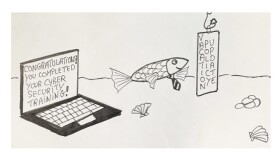Back when Grant Hosford's older daughter was in first grade, she signed up for an extracurricular class, building robots with a programmable Lego toy called Mindstorms. Hosford, a dot-com entrepreneur, came to visit the class and was startled to see that Naomi, who loves science and math, was both the only girl there and the youngest by a couple of years.
"My first reaction was not, 'Oh, I'm going to go build a coding company.' My first reaction was, 'What can I build for my daughter that will help her down this path?' "
Hosford did go on to be a co-founder of a company called codeSpark. Its gamelike software, The Foos, teaches basic computer programming skills — "the ABCs of coding"— with no reading necessary. It's aimed at children as young as 5, and it has been downloaded 700,000 times so far in 150 countries.
The Foos is part of a trend toward increasing emphasis on code as a fundamental literacy. You may have heard about the Hour of Code nonprofit initiative, which claims tens of millions of student participants; or New York City Mayor Bill DeBlasio's recent announcement that he intends to require teaching of computer science in all grades for all students.
"A computer science education is literacy for the 21st century," the mayor said at the announcement.
Educators, researchers and entrepreneurs like Hosford are taking that analogy very seriously. They're arguing that the basic skills of coding, such as sequencing, pattern recognition and if/then conditional logic, should be introduced alongside or even before traditional reading, writing and math.
Programming Primer
To Hosford, this early introduction is key to broadening participation in STEM disciplines. "If we were teaching coding like reading and math, we would break it down into bite-size chunks, make it more fun with songs and stories, and give students two decades to reach mastery," Hosford says. "With coding we throw you in the deep end in high school or college and are surprised when most kids drown."
According to this thinking, the skill sets required for coding and the three Rs will all reinforce each other. And the engaging nature of many gamelike tech tools will help draw in young learners who may not be as inspired by traditional lessons. And there is some evidence for both of these claims.
Sam Patterson is a technology integration specialist at a private school in Silicon Valley. He's also the author of a forthcoming book on programming in the early grades. "The focus is on inspiring teachers to design digital lessons that use programming as a mode of expression, similar to what we would do with writing," Patterson says.
Along with The Foos, Patterson often uses Kodable, another app that doesn't require reading, as well as two more programs called Tynker and ScratchJr, to teach programming to young children. In a typical lesson, students might write a story and direct animated characters to act it out. Or they could use the program to build an animated model, say, of an ocean habitat.
"In ScratchJr, with first-graders you can ask them to create a moving model of something," Patterson says. "Say they're studying a coral reef: You can teach them about loops and ask them to create a model for a reef using fish and sharks. They swim back and forth, talk to each other, maybe one eats another one."
In the old days, this kind of project might have been done with crayons or a shoebox diorama. "We may have had students draw a picture," Patterson says. "Now we're upping the ante and giving them a more cognitively complex task to do, in addition" to the science content of the lesson.
The benefits, says Patterson, are manifold. "It's super high-engaging because the kids love programming and robots. We can get more learning objectives out of it." The students are practicing sequencing, putting ideas in a given order; and syntax, matching abstract symbols with ideas; both skills crucial for regular reading, writing and arithmetic.
The lure of software can help motivate reluctant readers and English-language learners, Patterson claims. "Up until second grade, I'm using programming to build literacy, and from the middle of second grade on, they're developing literacy to do better at coding," for example by reading the instructions within a game.
Skills In Sequence
Marina Umaschi Bers is a professor of both child and human development and computer science at Tufts University. She studies technology and early learning. She's also the co-developer of ScratchJr and a commercially available robotics kit called Kibo.
She has published small initial research studies in the past few years showing that working with a programming tool improved young children's skills on traditional sequencing tests and related tests of executive functioning. For example, before going through a robotics and programming curriculum, when asked to describe the process of brushing their teeth, children gave just three or four steps. Afterwards, they were able to break down the process into 20 or more steps.
"If you get better at sequencing, it has a measurable positive effect on reading comprehension," she says. "A parent can have their kid engage in coding with the knowledge that a lot of kids won't become programmers, but there is this broad-based benefit."
The idea of introducing software widely in kindergarten or even preschool is not without controversy. Victoria Dunckley is a child psychiatrist in Los Angeles who has just published a book called Reset Your Child's Brain, about the dangers of technology use. She has prescribed total abstinence from screens to hundreds of patients, to cut back on the symptoms of a wide range of childhood mental ailments, from ADHD to OCD.
"Even educational screen time can cause a lot of issues," Dunckley says. "A lot of these kids can't tolerate any kind of screen time at all. I used to be able to just write a note for the kid to take to school to say, don't have any computer time. But that's changed with iPads and the Common Core."
She would prefer holding off introducing screens in classrooms until middle or even high school. "I am horrified by the flipped classroom," she said.
Bers and Patterson actually agree, to a point. They believe that in the early childhood years especially, long periods spent passively in front of a two-dimensional screen would be developmentally inappropriate.
"Working with tangible objects is fundamental for young kids," Bers says. That's why her Kibo robot kit can be programmed by physically rearranging wooden blocks, a system called CHERP. Similar to alphabet blocks, each one represents an instruction, such as "forward," "back" and "spin." They snap together to complete a "story" for the robot to act out.
It's important to "be able to move between on-screen and on-floor activities," Patterson agrees. His solution is robots. He often introduces programmable toys like Sphero, Ollie, Dash and Dot, which roll around and carry out simple instructions; remote-controlled airplanes; and LED lights that can be programmed to flash in colorful patterns.
"I've got first-graders who have the basic skills to program a smart house," he says. In addition, he usually has at least two students work together on each device, to help develop their social skills while they learn.
Besides fears about safety, and a lack of resources for devices and software, the third biggest obstacle to wider introduction of coding in kindergarten is probably a lack of knowledge and confidence on the part of teachers and parents. But Bers stresses that engaging kids in the expressive use of technology can start simply, with equipment you probably already have in schools or at home.
"Start with what the child wants to do, not with what the technology can do," she advises. "Make a card for Grandmother's birthday or a slideshow of your last vacation. Sometimes using Word can be very powerful."
Copyright 2022 NPR. To see more, visit https://www.npr.org. 9(MDAzMjM2NDYzMDEyMzc1Njk5NjAxNzY3OQ001))






